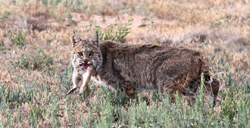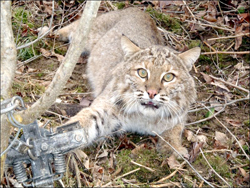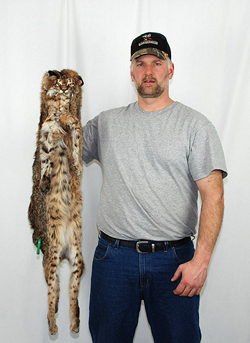Cuomo to Expand Bobcat Hunting
By Frank Parlato
Gov. Andrew Cuomo has instituted a state initiative to increase hunting in New York State, calling it "NY Open for Fishing and Hunting."
Now it looks like bobcat will be part of the expansion initiative and Western New York bobcats will be hunted for the first time in decades.
The New York State Department of Environmental Conservation (DEC) is proposing changes to regulations that would provide increased hunting and trapping opportunities for the "sportsmen" who go into the woods and kill bobcats.
Trappers, however, kill bobcats for their pelts, which fetch around $500 for a clean, nicely spotted one.
There are about 5,000 bobcats, the DEC estimates, in the state.
The Fish and Wildlife Service estimates that, nationwide, there are between 1.4 and 2.6 million bobcats across the U.S.
The bobcat population has increased over the past several decades throughout New York and the new plan, according to DEC Commissioner Joe Martens, will allow for some additional harvest with controls.
Bobcats occupy about one-quarter of New York, mainly in the Adirondack, Catskill, and Taconic regions. While thought to no longer exist in Western New York, multiple confirmed sightings of bobcats -- including dead specimens -- have been reported in Western New York's Southern Tier.
“The changes to the bobcat hunting and trapping seasons will increase opportunities for New York sportsmen and women, accompanied by rigorous monitoring requirements to ensure that harvest levels are sustainable,” Martens said.
For those who have never seen one, bobcats are about twice the size of a domestic cat. Males, on average, weigh about 20 pounds and females about 14 pounds. They are about three feet long with a 6-inch tail. They are not easy to hunt. A solitary animal, you could live your whole life in the woods and never see one.
In states like New York, that don’t allow the use of hounds, the success rates on such hunts is below one percent, and they usually have to be undertaken in winter weather conditions. The season runs from Oct 25th to Feb 15th.
A study of the Adirondack region showed there were five bobcats for every 100 square miles. The Catskills had 16 bobcats for every 100 square miles.
The bobcat is a predator. His preferred prey is the rabbit and hare, but will hunt rodents, insects, skunks, minks, foxes, squirrels, birds and, coming closer to civilization, chickens, goats, small dogs, domesticated cats and road kill. The bobcat will sometimes prey on larger animals, generally on fawns up to eight times its own weight. The kill is made by grabbing it by the neck then biting the throat, base of the skull, or chest.
A growing demand in China, Russia, Italy and other countries for fur coats made of bobcat pelts has boosted prices, encouraging trappers. One pelt of beautiful fur sold for $1,200. The number of pelts exported from the U.S. was 31,680 in 2007.
According to Brian MacMillan, vice president of the U.S. division of North American Fur Auctions, the soft, spotted bobcat pelts are currently pulling down higher prices than any other species of North American animal.
"It’s one of the hottest furs today,” he added. “It’s definitely a high-fashion piece” overseas.
Live, humane traps are not often used for the bobcat since the cat will rarely enter a wooden cage, and the frenzied, trapped bobcat will rip up their feet and faces and, more importantly to trappers, rub their hair off in a wire cage.
Body-gripping traps and snares using sardines or wet cat food placed in a small tray at the back of the bucket, attracts the bobcat. He steps forward and is caught by the trap. While trappers are predominantly men, the end-users of bobcat fur are almost exclusively women.
Despite the new state initiative and the spotting of bobcat in Western New York, it might not be advisable to quit your day job and become a bobcat trapper.
Joel Blakeslee, president of the Nevada Trappers Association, said that most of the trappers in his organization are lucky if they earn $2,000 a year from bobcat pelts.
The state Bureau of Wildlife said it will continue monitoring bobcat populations to determine whether any important changes occur with the increase in hunting and trapping opportunities. The proposed regulations simplify season dates in areas where hunting and trapping seasons have been open for years. The plan establishes new hunting and trapping opportunities in wildlife management units across the Southern Tier.
For more information, go to http://www.governor.ny.gov/press/02202013-ny-open-for-fishing-and-hunting.


